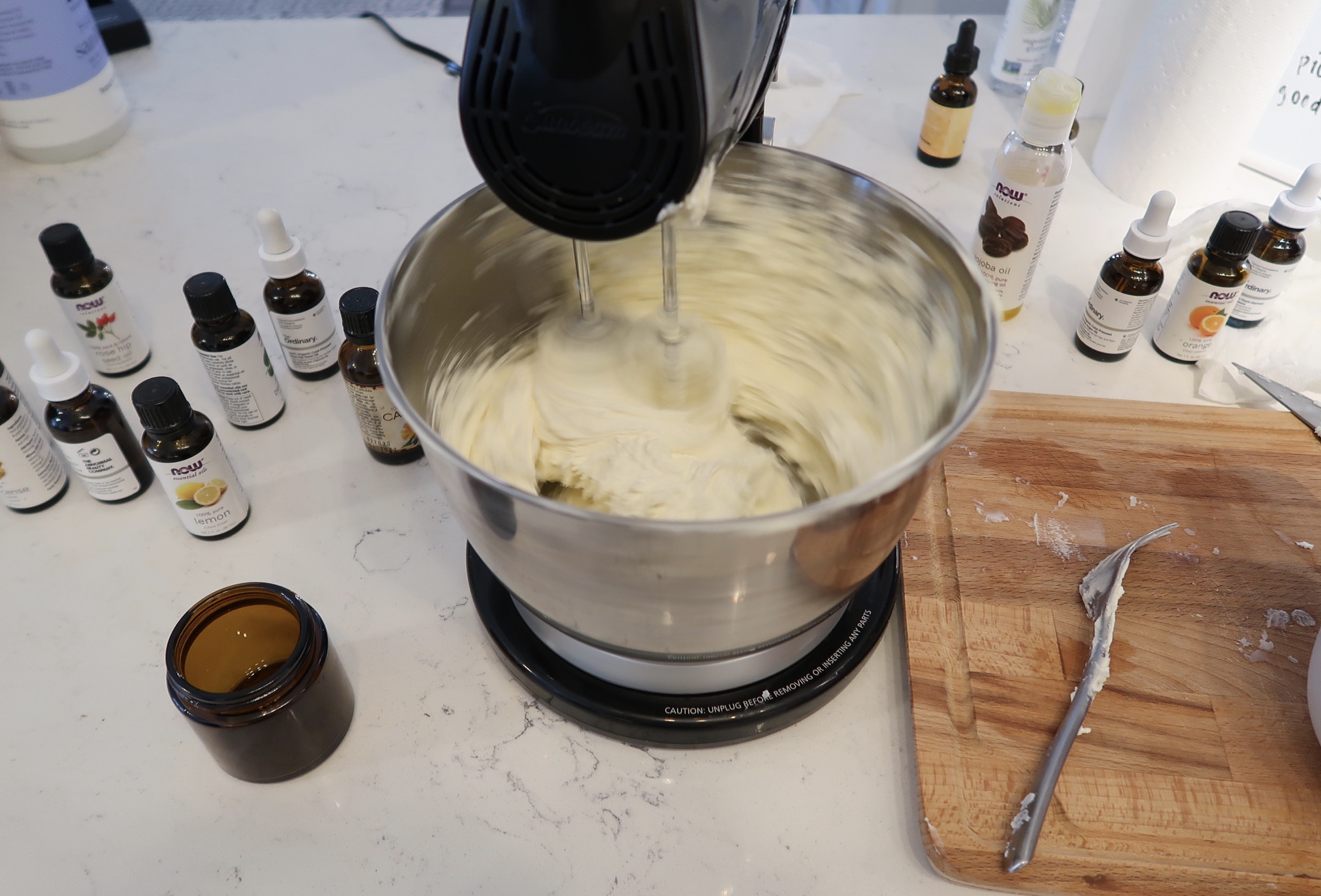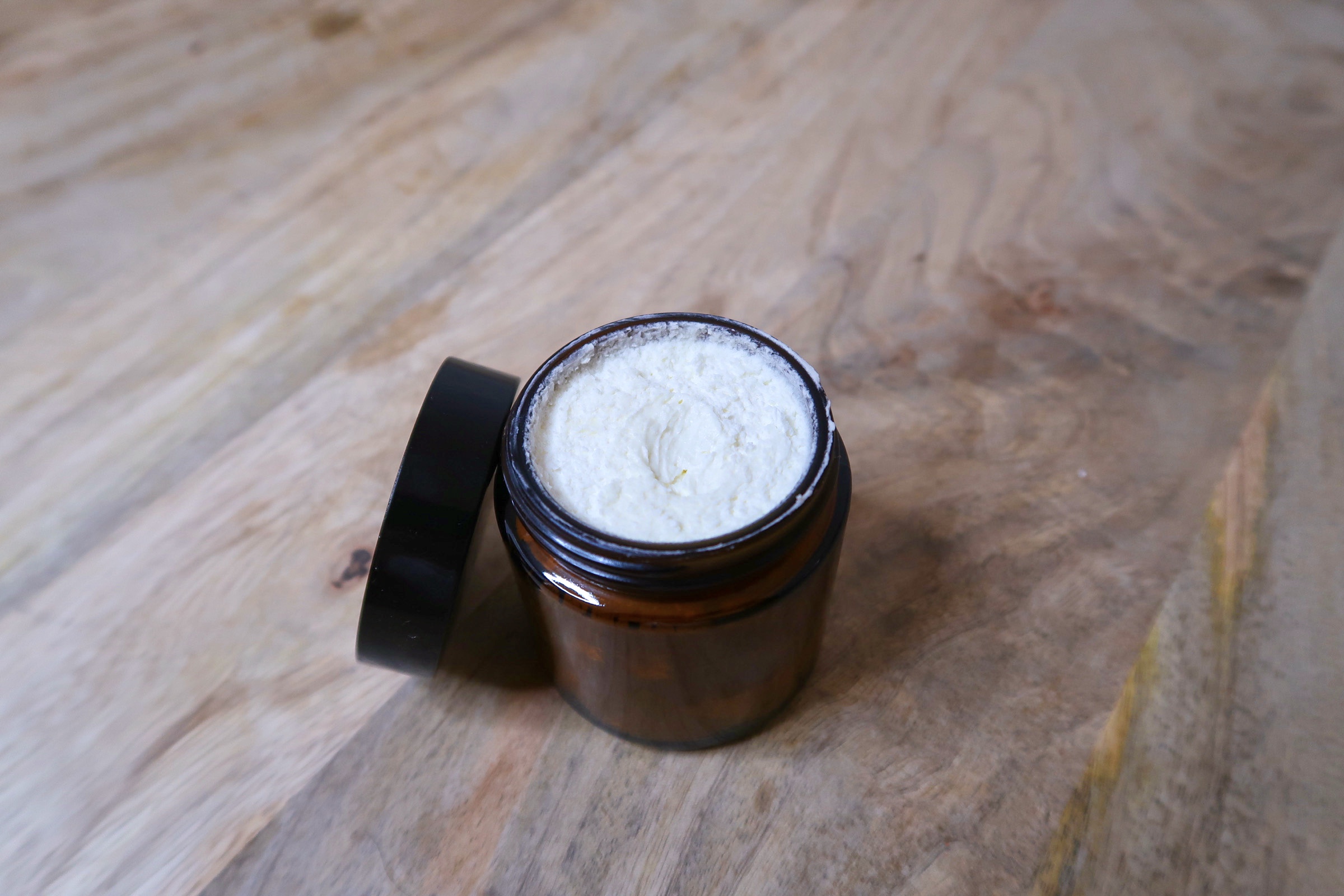Ever since I was a baby, I’ve suffered from severe eczema. I used to get horrible flareups that were swollen and itchy like no other. It was a constant battle of itchy, burning skin. I’d get eczema all over but my main flareups were in my arm and leg creases, and on my face. It was embarrassing! The worst part was, because I’m such a heavy sleeper, I’d itch in my sleep and wake up worse than before. So every night my mom would lather me up in this disgustingly thick eczema ointment and cream. As I’ve gotten older, it has gotten so much better and now I only have some flareups depending on my diet, allergies, or the weather.
Till this day, I have very dry skin. If I don’t drink enough water and moisturize daily, I get dry patches anyways. So, beginning at the end of high school, I was determined to figure out how to be in control of my skin. I began creating skin oils and creams that worked well. Eventually, even friends and family asked me to make them oils, too. My niece started getting eczema at 3 months and this gave me the idea to make this whipped eczema cream. In the future, I’d love to learn how to make my own oils from oranges, flowers, etc. but for now, I purchased pure, cold-pressed oils. The key here is just to make sure you’re buying 100% pure oils! There’s beauty in creating your own skincare. You’ll know exactly what’s in each product you create. You are in control of what goes into your products and onto your skin. This eliminates the chemicals, additives, and preservatives you may get from skincare products you purchase in stores.
Here is a recipe that I made and had great results with:
I took a few days doing research on different butters and oils to figure out what has been promising for dry skin and eczema. I decided to go with mango and shea butter as my base for this whipped cream. I whipped each butter separately then combined and whipped them with the rest of my chosen oils. You can use both, substitute either butter, or only use one if you prefer.

Mango Butter

Mango butter is non-comedogenic meaning it won’t clog your pores while moisturizing! This means it’ll work well for acne-prone skin. This emollient is great for dry skin and even used for hair. Mangoes are packed with antioxidants and a ton of vitamins including A, E, K, and C. It’s works wonders for dry skin and is the perfect summer skincare product. Because of mango butter containing vitamin A, it is also great for anti-aging to keep the skin healthy and firm. Make sure to buy pure mango butter to take advantage of the benefits.

How To Whip Mango Butter:
- Cut the mango butter into small squares, this allows for easier mixing. Whipping mango butter was messier than shea butter for me!
- Put it into the mixing bowl and smash it to make the butter softer. Pour about half a tablespoon of jojoba oil to start (*note that jojoba is best for whipping mango butter).
- Begin to whip it with an electronic mixer, adding more jojoba oil and your choice of essential oil as you go. Whip until it has the soft, cloud-like texture that you prefer.
- Store in an airtight, sanitized jar or container.
*1 drop essential oil to 1 teaspoon carrier oil.
*For babies 6 months-2 years old, 1 drop essential oil to 1 tablespoon carrier oil.
Shea Butter

Best when it is raw and organic, free from any additives, preservatives, or chemicals. When purchased raw, please note it may be semi-gritty from the nut. You can warm it and strain through a cheesecloth to remove the shea nut. Shea butter is a well-known emollient, used for hair, skin irritations from eczema and psoriasis, and even stretch marks and scarring. Shea butter has vitamins A, E, and F, and is anti-inflammatory. It is also a great a anti-aging agent.
How to whip Shea butter:
- Heat shea butter on a pan on the lowest heat setting so it doesn’t burn.
- Once it’s fully melted, turn off the stove and move the pan to let cool. You can add jojoba oil or other carrier oils while it’s cooling down, no essential oils yet.
- Once it’s at room temperature, add desired essential oils and begin to mix it with an electronic mixer as oil for about 2 minutes.
- Put the oil in the fridge so it can begin to slightly solidify before we mix it again.
- Check on the shea butter after about 20 minutes. You want it to still be soft enough to whip!
- When it’s ready, use the mixer to whip the shea butter. You can add more oils if you’d like!
- Store in an airtight, sanitized jar or container. I used 4 oz. amber jars after I mixed in mango butter.
*1 drop essential oil to 1.5 tablespoon carrier oil.
*For babies 6 months-2 years old, 1 drop essential oil to 1 tablespoon carrier oil.
Oils I used and prefer:
Frankincense
Sweet, woody scent. It has been known to have a number of benefits including alleviating stress, depression, and pain. In skincare, it helps protect skin cells, tightens the skin reducing signs of aging, and assists with blemishes. Frankincense is a great oil for dry skin and eczema. It’s also known for its healing properties, Frankincense, along with myrrh and other resins, are often used in spirituality, bringing spiritual awareness and protection, and even used in the Bible.
Lavender
This versatile floral essential oil is soothing and calming. It’s commonly used for skincare, haircare, teas, and cleaning products. It’s popular for relaxation, used headache and stress relief. Lavender helps to soothe itchiness and reduce inflammation, which is key for eczema. Since it is a soothing and helps to balance the skins moisture, it’s good for wrinkles, acne, oily skin, and dry skin.
Calendula
Anti-septic, anti-fungal, and antibacterial. It has been used for muscle spasms, jaundice, measles, and smallpox. Calendula flower (pot marigold) is used to make medicine and to treat wounds. This oil works well to calm eczema and is also used for slowing formation of wrinkles. Calendula has been used for acne and treating dark spots.
Jojoba
Jojoba is a very popular oil for a reason. It has a ton of benefits and works for just about every skin type. Jojoba is a humectant and is non-comedogenic which means it really locks in moisture but will not clog your pores while working it’s magic. Jojoba also helps with eczema, psoriasis, aging, sunburns, and even scars. It contains vitamins, anti-oxidants, and fatty acids, making it versatile for both hair and skin.
Borage and Rosehip
Borage oil comes from the plant Borago Officinalis, derived from it’s seeds. This oil is a top choice for skin conditions including eczema, rosacea, psoriasis, and even acne. It has a high content of GLA (gamma linoleic acid) which has been found to act as a hormone in your body to treat inflammation when taken orally. However, it is more promising when used topically for eczema. I bought mine pure and organic here.
Rosehip seed oil is another underrated oil containing linoleic acid. Rosehip is one of my favorite oils to use because it’s universal. It’s great for all skin types since it is non-comedogenic and high in vitamins A and C. Add this to your collection for wrinkles, eczema, redness, or even combination skin. I found my 100% organic cold-pressed rosehip oil from The Ordinary.
Argan
Another popular non-comedogenic oil. Argan oil works well with acne-prone skin and improves skin elasticity, helping reduce signs of aging. It’s favored for strengthening hair. Argan oil contains linoleic acid and is less likely to clog pores or cause breakouts. It’s packed with fatty acids and vitamins A and E and sinks into the skin quick which means it’s very hydrating. Get inexpensive pure argan oil here.
Orange and Lemon
I added both of these citrus oils for their delicious scents plus their boost of vitamin C. They’re useful for brightening the skin, collagen production, and the anti-inflammatory properties help with acne! Not only do these two uplift your mood, lemon and orange promote radiance for your skin. These simple oils are widely used in anti-aging and acne creams.

Please feel free to add or exclude any oils that you dislike or may be allergic to! There are a wide variety of other carrier and essential oils that I could’ve included but these have been very good for my skin. Other great oils to consider are coconut oil and grapeseed oil. If you are interested in the science behind each oil, I encourage you to look up each one on different medical journals or ask a naturopathic doctor!
Disclaimer: ‘DIY’ recipes are simply my opinion that have proven to be effective but have no claims, promises, or guarantees. All recipes you make and use are done so at your own risk. Please seek professional medical assistance as I am not a medical professional. The information provided is created from public information and is only to be used as a guide for personal use. If you are nursing, pregnant, or have illnesses, please contact your healthcare professional.
Patch tests should be done to ensure there are no allergic reactions etc. Test on arm or leg and watch over area for 24 hours. Steer clear of oils that come from seeds, fruits, and/or nuts if you are or have been allergic in the past.
